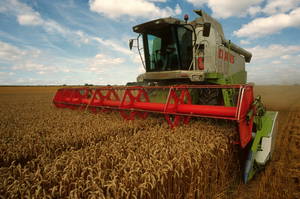 nditions in various countries and political tensions in the Black Sea region have made food markets more volatile, FAO reports in the new Food Outlook.
nditions in various countries and political tensions in the Black Sea region have made food markets more volatile, FAO reports in the new Food Outlook.In its first major forecast for 2014, FAO puts cereal production at 2 458 million tonnes (including milled rice), down some 2.4 percent from the 2013 record, though global output is still expected to be the second largest ever.
The decline is likely to be more pronounced for coarse grains. Still, inventory levels remain fairly good. Analysts say there is no cause for concern at this early stage before the main 2014/2015 seasons get underway -- assuming trade flows are not negatively affected by tensions in the Black Sea region.
Overall, world cereal stocks are expected to remain at relatively comfortable levels, according to the report, a biannual publication which provides information on the short-term market situation and outlook for major food stuffs. Lower pricing and El Niño weather conditions may keep world rice production lower in 2014, especially in Asia. In Thailand, a softening of producer prices could be the main factor leading to a contraction in rice planting and production.
While production may be lower, international trade could expand to record levels in 2014, sustained by ample supplies in exporting countries and increased purchases by traditional importers like Bangladesh, Indonesia and the Philippines.
The 2014 global food import bill could stabilize at $1.29 trillion but animal product bills are set to increase, sustained by rising trade volumes and prices, the report says.
Meat and dairy
Meat and milk production are both expected to grow in 2014. World meat production is expected to grow modestly to 311.8 million tonnes, an increase of 1.1 percent over 2013, reflecting growth in the developing countries, which are mainly behind the rising global demand.
There are marked differences in projected trade among meat varieties, with bovine and poultry meat on the upswing and ovine products and pork on the decline. Poultry remains the main product traded, claiming 43 percent of the total market, followed by beef, pork and mutton, respectively.
While international prices for meats have remained at historically high levels since the beginning of 2011, with no sign of an overall decrease, international dairy prices declined in March and April, registering levels close to those of a year ago.
Milk trade is forecast to rise 1.8 percent, reaching 69 million tonnes, and driven primarily by increasing demand from Asia.
Fisheries
The economic recovery in traditional markets such as the United States and the European Union is boosting overall demand for fish and fishery products, along with the already firm interest of emerging economies like Brazil and Mexico.
This demand, coupled with supply shortages for a number of farmed and wild species, has boosted overall price levels. Once again, weather may come into play as El Niño weather patterns could reduce some catches in South America.
The most popular species include salmon, shrimp, pangasius and tilapia from acquaculture, and shrimp, squid, octopus and herring from capture fisheries. Prices have softened somewhat for tuna, mackerel and cod.
Oils and meals
In 2013/2014, oil and meal prices moved upward, reflecting a tight balance in the United States, slowed growth in palm oil production, and cuts in soybean production estimates.
Global consumption of both oils and meals is set to continue expanding, stimulated by higher supplies and driven by growing demand in developing countries in Asia, though consumption could grow less than expected, amid firm international prices and ample maize availability.
Sugar
Sugar production was showing marginal declines but trade is expected to be higher amid increased demand from importing countries.
Food Price Index
FAO also issued its monthly Food Price Index, which averaged 209.3 points in April 2014, down 3.5 points, or 1.6 percent, from March, and 7.6 points, or 3.5 percent, below April 2013. Last month's decline was mostly caused by a sharp drop in dairy prices, although sugar and vegetable oil also fell. By contrast, cereals and meat prices were slightly firmer.





